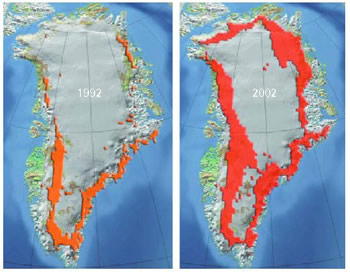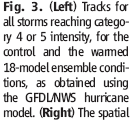
Bio 320- Fundamentals of Ecology
Class Meetings Week of 31 January 2012 (week 4)
"Changing Climates"

http://www.commondreams.org/headlines06/0210-07.htm
(source: accessed Feb.2006)
FALL MEETING OF THE AMERICAN GEOPHYSICAL UNION, 14-18 DECEMBER 2009, SAN FRANCISCO, CALIFORNIA:Antarctic Glacier Off Its Leash
An unmanned autonomous submarine has discovered a sea-floor ridge that may have been the last hope for stopping the now-accelerating retreat of the Pine Island Glacier, a crumbling keystone of the West Antarctic Ice Sheet, researchers announced at the fall meeting of the American Geophysical Union.An unmanned autonomous submarine has discovered a sea-floor ridge that may have been the last hope for stopping the now-accelerating retreat of the Pine Island Glacier, a crumbling keystone of the West Antarctic Ice Sheet. The ridge appears to have once protected the glacier, but no more. The submarine found the glacier floating well off the ridge and warmer, ice-melting water passing over the ridge and farther under the ice. And no survey, underwater or airborne, has found another such glacier-preserving obstacle for the next 250 kilometers landward.The Pine Island and adjacent Thwaites glaciers are key to the fate of West Antarctic ice, says glaciologist Richard Alley of Pennsylvania State University, University Park, in an e-mail. And West Antarctica is key to how fast and far sea level will rise in a warming world. "To a policymaker, I suspect that the continuing list of [such] ice-sheet surprises is not reassuring," he writes. At the meeting, glaciologist Adrian Jenkins of the British Antarctic Survey in Cambridge and colleagues described how the instrument-laden Autosub3 cruised for 94 hours along 510 kilometers of track beneath the floating portion of the Pine Island Glacier in January 2009. The sub found a 300-meter-high ridge across the ocean cavity formed by the floating end of the glacier. Deep, warmer water was overtopping the ridge and passing through the gap between floating ice and the ridge top on its way to melting back more of the glacier. That gap has been growing, Jenkins said, perhaps since the 1970s. An aerial photograph from 1973 shows a bump in the ice where the ridge is now known to be, suggesting that the ice was then resting on the ridge and no warmer water could have been getting through. Although the last physical obstacle to continued melting and retreat of the Pine Island Glacier has been breached, the ice's fate remains murky, says glaciologist David Holland of New York University in New York City. That's because glaciologists aren't sure what got the glacial retreat started in the first place, he notes. It wasn't the greenhouse simply warming the ocean, researchers agree. Instead, shifting winds around Antarctica in recent decades may have driven warmer waters up to the ice and dislodged it from its perch on the ridge. But what caused the winds to shift? Global warming? The ozone hole? Random variability? Glaciologists—and policymakers—would like to know. |





Announcements:
For class on 2/7:
On paper, draw a simple conceptual model of a forest
ecosystem, using arrows to indicate carbon flow. Be sure to
include all of the biological (& physical) processes you can think of
that influence carbon flow. Bring two copies to
class – 1 to turn in, 1 to use in class for discussion.
Individual assignment.
Other Congressional News
Murkowski Leads Effort to Block EPA Regulation of Greenhouse Gases. Senate Energy and Natural Resources Committee Ranking Member Lisa Murkowski (R-AK) has introduced a Resolution of Disapproval that would prevent the EPA from regulating greenhouse gas emissions by blocking the agency's recent finding that greenhouse gases endanger the public's health and welfare. Thirty-five Republicans co-sponsored the measure, including Senator Lindsey Graham (R-SC), who is working with Senators Kerry (D-MA) and Lieberman (I-CT) to develop a compromise climate bill. Co-sponsors also included three Democrats: Agriculture, Nutrition and Forestry Chair Blanche Lambert Lincoln (D-AR), Sen. Ben Nelson (D-NE), and Sen. Mary Landrieu (D-LA). Graham said his support of the resolution did not preclude his efforts on a climate bill, stating, "If you vote to pre-empt the EPA – which I'm willing to do – I think there's a burden on you as a United States Senator to deal with the issue" of climate change.
Tuesday: Main Goals
Addressing points raised in the IPCC "Summary for Policy Makers" report -

Thursday: Exam 1